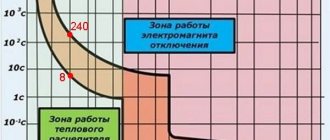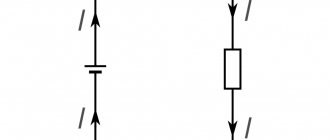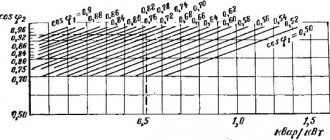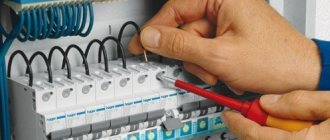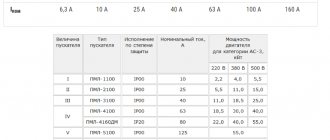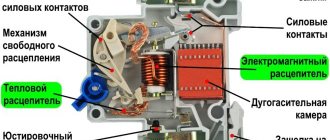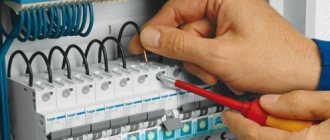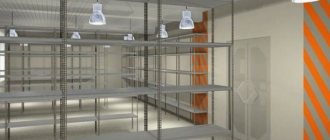To select the cross-section of power cables and wires when laying electrical networks for consumers, you need to know what power devices will be included in them. You can learn how to calculate the power consumption of an electrical appliance by understanding the very concept of power. For this, information from the school curriculum and basic concepts about current, voltage, and resistance will be enough. In addition, this knowledge is needed when purchasing household electrical appliances.
Electric current power
Total power and its components
Electrical power is a quantity responsible for the rate of change or transmission of electricity. The total power is denoted by the letter S and is found as the product of the effective values of current and voltage. Its unit of measurement is volt-ampere (VA; V A).
Total power can consist of two components: active (P) and reactive (Q).
Active power is measured in watts (W; W), reactive power is measured in vars (Var).
It depends on what type of load is included in the electricity consumption circuit.
Active load
This type of load is an element that resists electric current. As a result, the current does the work of heating the load, and the electricity is converted into heat. If a resistor of any resistance is connected in series to a battery, then the current passing through the closed circuit will heat it until the battery is discharged.
Attention! An example of a thermal electric heater (TEH) can be given as an active load in AC networks. The heat generated on it is the result of the work of electricity.
Similar consumers also include spirals of light bulbs, electric stoves, ovens, irons, and boilers.
Capacitive load
Such loads are devices that can accumulate energy in electric fields and create movement (oscillation) of power from source to load and back. Capacitors, cable lines (capacitance between conductors), capacitors and inductors connected in series and parallel in a circuit serve as capacitive loads. Sound power amplifiers and synchronous electric motors in overexcited mode also load the lines with a capacitive component.
Inductive load
When the consumer of electricity is certain equipment, which includes:
- transformers;
- three-phase asynchronous motors, pumps.
On the plates attached to the equipment you can see such a characteristic as cos ϕ. This is the phase shift coefficient between current and voltage in the alternating current network into which the equipment will be connected. It is also called the power factor; the closer cos ϕ to unity, the better.
Important! When a device contains inductive or capacitive components: transformers, chokes, windings, capacitors, the sinusoidal current lags in phase with the voltage by a certain angle. Ideally, the capacitance provides a phase shift of -900, and the inductance provides a phase shift of +900.
Cos ϕ values depending on the type of load
The capacitive and inductive components together form reactive power. Then the total power formula looks like:
S = √ (P2 + Q2),
Where:
- S – apparent power (VA);
- P – active part (W);
- Q – reactive part (Var).
If we display this graphically, then we can see that the vector addition of P and Q will be the total value of S - the hypotenuse of the power triangle.
Graphic explanation of the meaning of total power
Joule-Lenz Law Formula
We have calculated the value of the resistor for making a load block for the computer power supply, but we still need to determine what power the resistor should have? Another law of physics will help here, which was discovered simultaneously by two physicists independently of each other. In 1841 James Joule, and in 1842 Emil Lenz. This law was named after them - the Joule-Lenz Law
.
The power consumed by the load is directly proportional to the applied voltage and the flowing current.
In other words, when the voltage and current change, the power consumption will change proportionally.
where P
is power, measured in watts and denoted by
W
;
U
– voltage, measured in volts and denoted by the letter
B
;
I
– current strength, measured in amperes and denoted by the
letter A.
Knowing the supply voltage and current consumed by an electrical appliance, you can use a formula to determine how much power it consumes. Just enter the data in the boxes below in the online calculator.
| Online calculator to determine power consumption | |
| Voltage, V: | |
| Current strength, A: | |
The Joule-Lenz law also allows you to find out the current consumed by an electrical appliance by knowing its power and supply voltage. The amount of current consumed is necessary, for example, to select the wire cross-section when laying electrical wiring or to calculate the rating.
| Online calculator for determining current strength depending on power consumption | |
| Power consumption, W: | |
| Supply voltage, V: | |
For example, let's calculate the current consumption of a washing machine. According to the passport, the power consumption is 2200 W, the voltage in the household electrical network is 220 V. We substitute the data in the windows of the calculator, we find that the washing machine consumes a current of 10 A.
Another example: you decide to install an additional headlight or sound amplifier in your car. Knowing the power consumption of the installed electrical appliance, it is easy to calculate the current consumption and select the correct wire cross-section for connection to the vehicle's electrical wiring. Let’s say that an additional headlight consumes a power of 100 W (the power of the light bulb installed in the headlight), the on-board voltage of the car network is 12 V. We substitute the power and voltage values in the windows of the calculator, we find that the current consumed will be 8.33 A.
Having understood just two simple formulas, you can easily calculate the currents flowing through the wires, the power consumption of any electrical appliances - you will practically begin to understand the basics of electrical engineering.
Negative effects of reactive load
Learn to easily calculate the power consumption of an electrical appliance
The reactive load does not perform any useful work. Fluctuations in the reactive component from source to consumer only cause parasitic losses. In addition, industrial enterprises are required to pay for the reactive energy supplied to them. This is due to the fact that most energy receivers are electric motors and transformers. The amount of electricity consumed (kWh) does not all go to useful work, but you also need to pay for its reactive component.
Capacitor compensation units will help solve this problem. After all, if you connect a capacitive load in parallel with an inductive load, you can reduce the effect of parasitic currents to a minimum. Such installations are installed at substations supplying consumers.
Why Circuit Reactance Affects AC Power
A sinusoidal voltage harmonic, entering a resistive resistance, changes the magnitude of the current without its deviation on the complex plane.
Such current performs useful work with minimal energy losses, generating active power. The frequency of the signal does not have any effect on it.
The resistance of the capacitor and inductance depends on the frequency of the harmonic. Its opposition deflects the direction of the current on each of these elements in different directions.
Such processes are associated with the loss of part of the energy for useless transformations. They consume power Q, which is called reactive. Its influence on the total power S and the connection with active P is conveniently represented graphically by a right triangle.
I wanted to draw it against the background of equipment made from piles of porcelain and metal, where I had to work for quite a long time. Got distracted. Don't judge harshly for this.
Compare it with the resistance triangle I published earlier. Do you find any common features?
They are the geometric proportions of the figure, the formulas describing them and the angle φ, which determines the total power loss. Let me move on to a more detailed consideration of them.
Formula for calculations
How to calculate electrical energy consumption
All data necessary to be substituted into the formula for calculations can either be measured or taken from the characteristics of the instruments used.
For your information. If the passport data indicates the value of cos ϕ, it means that the electricity received by the device will have a reactive component. This also needs to be taken into account when calculating.
The formula for calculation is:
P = I * U * cos ϕ,
Where:
- I – current in amperes;
- U – voltage in volts;
- cos ϕ – phase shift.
In the case of an active load, the phase shift is not substituted into the formula, and it has the form:
P = I * U.
Ohm's Law Formula
In 1827 Georg Simon Ohm
discovered the law of electric current. The Law and the unit of measurement of resistance were named after him. The meaning of the law is as follows.
The thicker the pipe and the greater the water pressure in the water supply (as the diameter of the pipe increases, the resistance to water decreases) - the more water will flow. If we imagine that water is electrons (electric current), then the thicker the wire and the higher the voltage (as the cross-section of the wire increases, the current resistance decreases) - the greater the current will flow through the circuit section.
The current flowing through an electrical circuit is directly proportional to the applied voltage and inversely proportional to the value of the circuit resistance.
where
I
is the current strength, measured in amperes and denoted by the letter
A
;
U
– voltage, measured in volts and denoted by the letter
B
;
R
– resistance, measured in ohms and denoted
Om
.
If the supply voltage U
and the resistance of the electrical appliance
R
, then using the above formula, using an online calculator, it is easy to determine the strength of the current flowing through the
circuit I.
| Online calculator for determining current strength | |
| Voltage, V: | |
| Resistance, Ohm: | |
Using Ohm's law, the electrical parameters of electrical wiring, heating elements, and all radio elements of modern electronic equipment, be it a computer, TV or cell phone, are calculated.
Features of calculation
To calculate power without having complete data on current and voltage consumption, you can use average characteristics. By consulting reference books, you can find out that lighting equipment can consume current up to 15 A. The maximum current of powerful devices reaches 50-60 A. The power factor, if it is not indicated or known, can be taken as 0.7 - this is the average value.
Single-phase voltage in a household network is 220 V. Its linear value in three-phase networks is 380 V.
Mathematical operations
The basic formula allows you to calculate an unknown quantity when the other two are known. For example, if the current consumed by the device is known I = 2 A and the network voltage U = 220 V, then the power consumption is equal to P = 2 * 220 = 440 W.
For example, it is known that the iron consumes 2 kW, and the voltage in the outlet is 220 V, then you can find the current strength for which the cross-section of the power cord is designed.
I = P/U = 2000/220 = 9.1 A.
In the case of fractional values, when using a calculator for calculations, the obtained values are rounded to tenths of the units of the desired value.
Basic formulas for calculation
Selecting the rating of the circuit breaker
Applying the formula I = P/209, we find that with a load with a power of 1 kW, the current in a single-phase network will be 4.78 A. The voltage in our networks is not always exactly 220 V, so it would not be a big mistake to calculate the current strength with a small margin like 5 A for every kilowatt of load. It is immediately clear that it is not recommended to connect an iron with a power of 1.5 kW to an extension cord marked “5 A”, since the current will be one and a half times higher than the rated value. You can also immediately “graduate” the standard ratings of the machines and determine what load they are designed for:
- 6 A – 1.2 kW;
- 8 A – 1.6 kW;
- 10 A – 2 kW;
- 16 A – 3.2 kW;
- 20 A – 4 kW;
- 25 A – 5 kW;
- 32 A – 6.4 kW;
- 40 A – 8 kW;
- 50 A – 10 kW;
- 63 A – 12.6 kW;
- 80 A – 16 kW;
- 100 A – 20 kW.
Using the “5 amperes per kilowatt” technique, you can estimate the current strength that appears in the network when connecting household devices. You are interested in peak loads on the network, so for the calculation you should use the maximum power consumption, not the average. This information is contained in the product documentation. It is hardly worth calculating this indicator yourself by summing up the rated powers of the compressors, electric motors and heating elements included in the device, since there is also such an indicator as the efficiency factor, which will have to be assessed speculatively with the risk of making a big mistake.
When designing electrical wiring in an apartment or country house, the composition and passport data of the electrical equipment that will be connected are not always known for certain, but you can use the approximate data of electrical appliances common in our everyday life:
- electric sauna (12 kW) - 60 A;
- electric stove (10 kW) - 50 A;
- hob (8 kW) - 40 A;
- instantaneous electric water heater (6 kW) - 30 A;
- dishwasher (2.5 kW) - 12.5 A;
- washing machine (2.5 kW) - 12.5 A;
- Jacuzzi (2.5 kW) - 12.5 A;
- air conditioner (2.4 kW) - 12 A;
- Microwave oven (2.2 kW) - 11 A;
- storage electric water heater (2 kW) - 10 A;
- electric kettle (1.8 kW) - 9 A;
- iron (1.6 kW) - 8 A;
- solarium (1.5 kW) - 7.5 A;
- vacuum cleaner (1.4 kW) - 7 A;
- meat grinder (1.1 kW) - 5.5 A;
- toaster (1 kW) - 5 A;
- coffee maker (1 kW) - 5 A;
- hair dryer (1 kW) - 5 A;
- desktop computer (0.5 kW) - 2.5 A;
- refrigerator (0.4 kW) - 2 A.
How to connect a pass-through switch: connection diagrams
Calculation of cable cross-section by power: practical advice from professionals
The power consumption of lighting devices and consumer electronics is small; in general, the total power of lighting devices can be estimated at 1.5 kW and a 10 A circuit breaker is sufficient for a lighting group. Consumer electronics are connected to the same outlets as irons; it is not practical to reserve additional power for them.
If you sum up all these currents, the figure turns out to be impressive. In practice, the possibility of connecting the load is limited by the amount of allocated electrical power; for apartments with an electric stove in modern houses it is 10 -12 kW and at the apartment input there is a machine with a nominal value of 50 A. And these 12 kW must be distributed, taking into account the fact that the most powerful consumers concentrated in the kitchen and bathroom. Wiring will cause less cause for concern if it is divided into a sufficient number of groups, each with its own machine. For the electric stove (hob), a separate input with a 40 A automatic circuit breaker is made and a power outlet with a rated current of 40 A is installed; nothing else needs to be connected there. A separate group is made for the washing machine and other bathroom equipment, with a machine of the appropriate rating. This group is usually protected by an RCD with a rated current 15% greater than the rating of the circuit breaker. Separate groups are allocated for lighting and for wall sockets in each room.
You will have to spend some time calculating powers and currents, but you can be sure that the work will not be in vain. Well-designed and high-quality electrical wiring is the key to the comfort and safety of your home.
Rules for calculating power consumption
In everyday life, when the need arises to independently determine the power consumption of electricity, do the following:
- determine the voltage required to power the device;
- find out the rated current from the passport data.
How to find out the power of an electrical appliance if not a single parameter is known? Household electrical appliances are designed for 220 V.
To determine power, it is permissible to measure current consumption. This can be done using an ammeter. It is connected to the circuit in series, having previously set the highest measurement limit - at least a hundred amperes. Current clamp meters will help you easily measure current, for which one of the conductors is grasped by the clamp sensor, and the readings are displayed on the display. Knowing the voltage, multiply it by the measured current to obtain the amount of power consumed.
Clamp meter
Calculation of light bulb power
The selection of incandescent lamp power depends on the desired level of illumination of the living space. One 100 W light bulb, working in the dark for at least 12 hours, consumes 1.2 kW of power. For a month this will be 36 kW, for a year - at least 432 kW. If there are 10 light bulbs in an apartment, then the total annual consumption will be 4320 kW. If the price for 1 kW of electricity is 5 rubles, the amount turns out to be decent – 21,000 rubles. Therefore, replacing incandescent lamps with energy-saving light sources: LED lamps, LED strips and the like allows you to save money. In addition, reducing the power of such light bulbs does not reduce the luminous flux. The reduced supply voltage of LED strips also reduces the amount of power consumed.
How power is indicated: units of measurement
In the table above, you saw the designation in watts, and when reading the instructions for household appliances, you will notice that the number of watts is necessarily indicated among the characteristics of the device. It is a unit of measurement of mechanical power used in the international SI system. It is designated by the letter W or W.
The measurement of power in watts was adopted in honor of the Scottish scientist James Watt, the inventor of the steam engine. He became one of the founders of the English industrial revolution.
In physics, the following designation for power is accepted: 1 W = 1 J / 1s.
This means that 1 watt is the power required to do 1 joule of work in 1 second.
In what other units is power measured? Astrophysicists measure it in ergs per second (erg/sec), and in the automotive industry you still hear about horsepower.
It is interesting that the author of this last unit of measurement was the same Scot James Watt. At one of the breweries where he conducted his research, the owner pumped water for production using horses. And Watt found out that 1 horse lifts about 75 kg of water to a height of 1 meter per second. That's how the horsepower measurement came about. True, today such a designation of power in physics is considered obsolete.
One horsepower is the power required to lift a 75 kg load 1 meter in 1 second.

